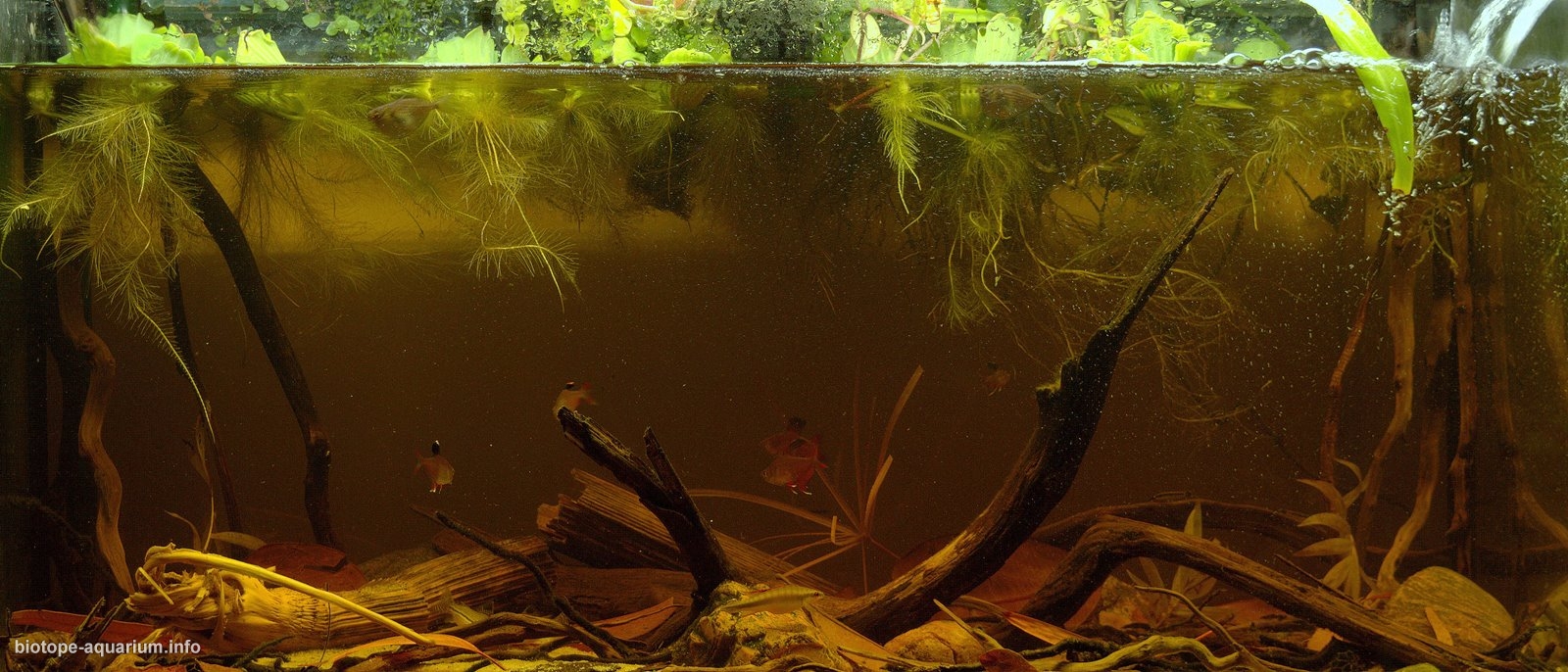Coastal part of the left affluent of lower Javari River, Peru
_th place in Biotope Aquarium Design Contest 2020

Volume: 200 litres
Dimensions: 100x40x50 cm
List of fishes: Crenicichla regani, Gasteropelecus sternicla, Hyphessobrycon bentosi, Otocinclus macrospilus, Corydoras trilineatus
List of plants: Pistia stratiotes
Description of decorations: The substrate is white quartz sand 0,5-1 mm with several rocks that were collected in the local creek. To recreate the great biodiversity of rainforest plants, I used the fallen leaves, pods, roots, branches and driftwood from approximately 15 plant species, collected in the wild and from some greenhouse plants. Some of the twisted branches and roots simulate the bunches of tree’s aerial roots growing to the water, that are abundant on the shores of actual biotope. The roots of some riparian plants also protrude into the water column, recreating the “atmosphere” of the river bank.
Description of equipment: The filtration was performed by Eheim 2217 canister filter and AquaEl FZN3 filter. AquaEl FZN3 with growing riparian plants, in fact, acts as a phytofilter. SUNSUN ADS-900c (80W) was used for lighting.
Water parameters: The temperature is 24-26°C, conductivity is about 40 ppm, pH is about 5.5
Additional info: –
INFORMATION ABOUT BIOTOPE
Description of the area surrounding the biotope: Rio Javari (Yavarí) is a 1,184 km long river, forming the natural border between Peru and Brazil. At the lower reaches, it forms numerous oxbows, lagoons and lakes. Javari shores are almost ubiquitously covered by dense rainforest. This area is remarkably rich in flora and fauna species, being one of the center of world biodiversity. Vale do Javari (Javari Valley) is one of the largest indigenous territories in Brazil, inhabited with about 2,000 uncontacted indigenous peoples belonging to at least 14 tribes.
Description of the underwater landscape of the biotope: As can be seen even from the satellite photos, Javari is a blackwater river, as well as it’s affluents. Because of the dense rainforest on the river banks, the sandy bottom is covered with fallen leaves, branches and driftwood. Some trees, growing just near the water, form a bunches of aerial roots, which are dangling into the water. The marginal riparian vegetation is also abundant. The water plants are represented mostly by flowing species. During the dry season the water level and surface area are significantly decreased, and the floating plants are accumulated in the riverbed, forming a thick layer of “floating meadows” and shading the underwater space (so, the bottom plants are rare in these places). In the wet season water depth and flow increases, and the streams flood the surrounding terrain, distributing the flowing plants over a large area.
Description of the parameters of the habitat: Water is generally tea-colored due to tannin staining, with tannin load variations depending on the season. The water is relatively harder and tannins level is higher during the dry season; in the rainy season water becomes softer and tannins level decreases because of the rain water intake. In different reports, such water parameters were scored for different Javari tributriaries: pH 5,16 – 5,46, conductivity 6 – 38 microSm/cm, temperature 25-27 °C
List of fishes and invertebrates occurring in the nature biotope: Fishes: Pterophyllum scalare, Mesonauta mirificus, Heros efasciatus, Apistogramma agassizii, Apistogramma bitaeniata, Apistogramma huascar, Crenicichla regani, Biotodoma cupido, Gasteropelecus sternicla, Crenuchus spilurus, Nannostomus marginatus, Carnegiella strigata, Copella vilmae, Pyrrhulina brevis, Paracheirodon innesi, Hyphessobrycon erythrostigma, Hyphessobrycon bentosi, Otocinclus macrospilus, Hypoptopoma gulare, Corydoras trilineatus, Tatia intermedia, Colomesus asellus, Bunocephalus coracoideus.
Invertebrates: Macrobrachium brasiliense, Palaemonetes ivonicus, Euryrhynchus amazoniensis.
List of plants found in the nature biotope: Pistia stratiotes, Eichhornia crassipes, Limnobium laevigatum, Azolla cristata, Echinodorus grisebachii, Salvinia natans, Hydrocotyle leucocephala.
Threats to the ecology: Like in many other similar areas, deforestation is the main threat to this territory and all who live there (including native people).
Sources of information:
The information about hydrobionts and plants distribution and ecology was given from web-sites
https://www.gbif.org, http://www.fishbase.org, https://www.seriouslyfish.com. All species of fishes and plants from this aquarium have georeferenced records from the lower Javari basin.
The information about Javari river drainage and surrounding area was given from websites:
https://www.google.ru/maps
https://en.wikipedia.org
https://www.researchgate.net
https://www.witpress.com/
https://www.youtube.com/watch?
Trip reports:
http://www.tomc.no/page.aspx?
http://www.tomc.no/page.aspx?
https://www.reef2rainforest.
https://www.facebook.com/
Because I didn’t manage to find any direct photo/video of Javari and it’s affluent underwater, I reconstructed the features of this place using the general information about blackwater rivers in the Upper Amazon basin, from various sources.
https://www.youtube.com/watch?
https://www.youtube.com/watch?
https://www.youtube.com/watch?
